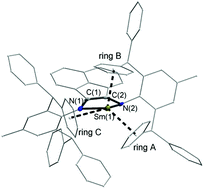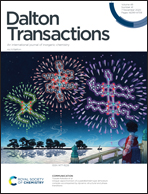Low-coordinate Sm(ii) and Yb(ii) complexes derived from sterically-hindered 1,2-bis(imino)acenaphthene (ArBIG-bian)†
Abstract
Reduction of ArBIG-bian (1, 1,2-bis[(2,6-dibenzhydryl-4-methylphenyl)imino]acenaphthene) with an excess of samarium in tetrahydrofuran (thf) and crystallization of the crude product from a thf/toluene mixture affords [(ArBIG-bian)Sm]·C7H8 (2a), which is free of the coordinating solvent. The use of 1,2-dimethoxyethane (dme) as the reaction medium resulted in the same product, [(ArBIG-bian)Sm]·C4H10O2 (2b), which differs from 2a only in the crystal lattice solvent. Reduction of 1 with an excess of ytterbium in dme gives compound [(ArBIG-bian)Yb(dme)]·2.5C7H8 (3), containing a coordinated dme molecule. All three products consist of dianionic ArBIG-bian ligands whose bulky 2,6-(Ph2CH)2-4-Me–C6H2 groups shield effectively the metal atoms. The newly prepared compounds 2a, 2b and 3 were characterized by 1H NMR and IR spectroscopy. The molecular structures of complexes 2a, 2b and 3 have been established by single crystal X-ray analysis. The intramolecular interactions were analysed on the basis of DFT calculations. The temperature dependence of the magnetic susceptibility of 2b and 3 in the region of 2–300 K was studied. The magnetic moments of complex 2b correspond to divalent samarium.



 Please wait while we load your content...
Please wait while we load your content...